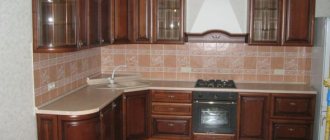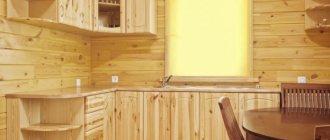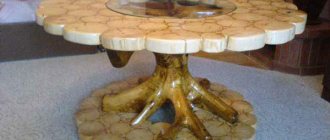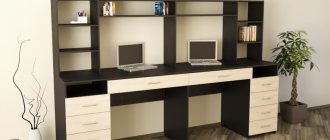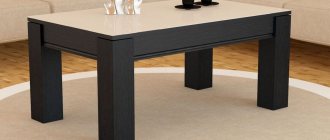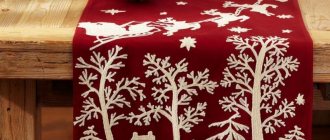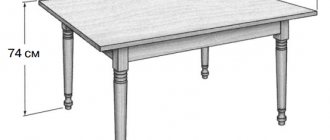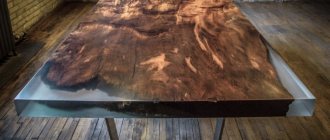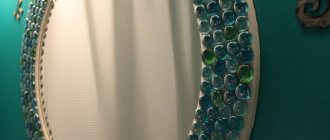The table is an important attribute of every modern kitchen. It can be made of various materials, any shape and size. An excellent solution is to choose a table made of natural wood - a beautiful, environmentally friendly and durable product. It will become a worthy decoration for a city apartment or country house.
In this article we will tell you how to make a kitchen table with your own hands from wood according to a finished drawing. We will provide step-by-step instructions with photos and videos of a difficult, but very interesting and exciting process.
Table dimensions
Before making a kitchen product, you should determine its dimensions. In this matter, it is important to take into account some nuances. So, the length and width depend on the area of the room and the future location.
At the same time, the table should naturally fit into the existing interior and be spacious. Fully perform the functions assigned to him.
In order for a person to be comfortable sitting at it, personal space cannot be less than 80 cm. Therefore, for a family of 4 people, the optimal dimensions of the table are 100 by 100 or 90 by 90 cm (when it can be installed in the middle of the room or moved away from walls so that each household member has their own side).
If it is impossible to move the table around the kitchen or the situation does not allow it to be installed in the middle, then it is better to give preference to a rectangular shape with sides of 80 and 130 cm. Two will be placed on the long side, the rest on the short side.
A large kitchen will be decorated with a large dining table with sides of 180 and 100 cm. It can easily accommodate up to twelve people.
Small kitchen spaces are best equipped with sliding or folding structures - in which additional inserts 50–60 cm wide are placed in the middle of the table.
The length of the sliding structure reaches 2.7 m, when folded - 1.7 m. As for the height of the future wooden product, it is determined by the configuration and height of the people sitting.
Most often, dining tables are made with a height of 60–80 cm, but there are also larger designs.
What to make shelves from
You can use ordinary chipboard sheets as shelves. From old furniture or just buy chipboard from a store. It is better to purchase laminated chipboard, but if this is not possible, then purchase an additional adhesive film. This will allow you to create lamination without the use of high temperatures and pressure. Chipboard thickness from 16 mm. and up to 25 mm. You can use plywood for shelves, but keep in mind that plywood really does not like moisture and its strength greatly depends on its thickness. It is better not to use plywood with a thickness of less than 10 mm for kitchen shelves.
how to determine load in kg
The shelf in the closet is designed for a specific load, usually 20 mm chipboard. withstands any household load. However, if you need to roughly determine the weight, you can calculate it. Books of standard textbook format or ABC edition 20x13 cm weigh 100 grams. 100 pages; larger books 29x21 cm weigh 300 grams. 100 pages. Utensils: steel frying pans up to 30 cm - 1 kg, steel pans 300-400 g. per liter, 2 liter steel kettle - 1 kg. Bed linen, kitchen towels 50 gr., bath towels 500 gr., sheets 500 gr., duvet covers 800 gr. Based on this, you can roughly calculate the load on the shelf.
Number of legs
After determining the dimensions of the kitchen product, no less attention should be paid to the number of legs:
- One massive leg is usually equipped with small-sized wood products that fit in a small kitchen. To give the structure rigidity and stability, use a cross-shaped strapping that can withstand increased mechanical loads;
- two legs are used for rectangular or oval tables. They are installed at an equidistant distance from one another. Most often, such stands have an elongated shape from top to bottom. They are comfortable because people sitting at the table do not hit their feet on the wood;
- The most popular are square, rectangular dining tables with four legs . This is the best solution for folding structures. To attach them, you do not need to perform complex calculations, because they are placed around the perimeter of the product. This table is strong, reliable, and very stable. The main thing is to correctly calculate the length, width of the lid and size of the legs during manufacturing. They must be of the same shape so that the furniture stands level and does not wobble during use.
Reliable fastening of the supports is ensured by blind or detachable collets. The latter option is more complex in design and allows for convenient transportation and storage of the product.
Definition of support
Before you start learning how to properly make a kitchen table with your own hands, you need to decide on the support. Of course, if the choice fell on a classic rectangular table, then the best support would be four legs in all corners for stability and reliability. However, you can opt for two massive legs if the table is not very large.
For small tables you can build one massive leg. Most often, such tables are used as coffee tables or garden tables. Less often - in small kitchens.
Wood selection
There are many different building materials that you can use when making your own dining table for the kitchen. But natural wood is considered the best.
The main thing is to choose the right material, size, shape of the tabletop and supports, which will extend the service life and ensure the product’s resistance to rotting and various types of mechanical damage.
Natural wood varies in density and can be soft, hard or very dense.
A countertop made of soft material is easier to process, but any scratches or traces of mechanical damage remain on it. The same cannot be said about the hardest and most dense rocks.
Soft varieties are used in the manufacture of kitchen tables:
- poplars;
- pine and spruce;
- cedar;
- fir;
- alders;
- chestnut;
- juniper.
Solids include:
- nut;
- birch;
- oak;
- maple;
- plum;
- elm;
- ash.
The following are considered very dense:
- acacia;
- Erman birch;
- boxwood;
- yew.
The best material for making a kitchen table yourself is oak - a high-strength, durable material that is not subject to deformation and moisture. It is easy to process and varnish.
Siberian larch and horse chestnut are no less popular. It is better to make the tabletop from pine, walnut or wenge, and the stand from acacia, birch or boxwood.
The table top can also be made from chipboard, plywood and fiberboard. The edges of such materials are laminated with vinyl film. Note that they are less durable and strong, they contain chemical components that are not harmless to human health, but are easy to process and affordable.
Self-adhesive film
Another great solution is to decorate an old table with self-adhesive film. Moreover, the modern market has a huge assortment of it - from simple plain to mirrored, luminous and imitating natural textures.
To cut the film correctly, you need to use the centimeter markings located on the back side of it. It is important to thoroughly clean the surface of the table, since the self-adhesive will instantly reflect all the flaws.
Glue the film slowly, pressing it tightly and at the same time smoothing it with a soft towel so that no air bubbles form.
Photo: in.pinterest.com
Photo: styledegree.sg
10 cool ideas on how to decorate your apartment for the New Year
Modern table models
Based on their design features, there are 4 types of dining tables that you can make yourself:
- classical;
- folding;
- sliding;
- made.
A classic wooden product is:
- rectangular;
- square;
- round;
- oval shape.
The production technology is multi-stage and requires skills in using carpentry tools. You will need to not only assemble the table correctly, but also decorate it beautifully.
Round tables are placed in large and spacious rooms in the center. They take up a lot of usable space and cannot be placed close to the wall. The round tabletop allows you to use a different number of supports - one or three, four. Two stands are not suitable, because the structure will be unstable.
A rounded wooden product can be placed in a small kitchen, but the table top in this case should not exceed 80 cm in diameter. For small spaces, the ideal solution is a small oval-shaped table, which will be an excellent addition to the soft corner.
The most common option is large or medium-sized kitchen products that fit well in standard apartments. They can seat a large number of people.
If the kitchen area does not allow you to install a large round table, you should use a sliding option. When folded, it takes an oval shape.
From the outside, folding structures look like compact bedside tables. They easily attach to the wall and take up little free space. When unfolded, the table can accommodate up to twelve people. It is not easy to make; you will need special tools and skills to use them.
The simplest option is a “book”, which is most often made from laminated chipboard. Sawing of the material and preparation of the elements can be done at a specialized enterprise. Assembling a table from ready-made parts will not be difficult. The individual parts of the lid are fastened together with steel hinges. The tabletop can also be made from natural wood, but this will significantly complicate the work process.
The sliding model of the dining table is no less easy to manufacture. Its main feature is its increased dimensions by inserting one or more functional panels in the middle of the cover. The parts are combined into a single structure with screws.
As for the sliding mechanism, in previous models, due to the lack of full rollback or roller guides, some effort was required to expand the table cover. At the same time, the elements rubbed and quickly became unusable.
Today's designs of dining tables are equipped with an improved mechanism that allows the elements to “roll out” without damaging the wood surface.
The simplest is the option with two steel guides, which can also be used as drawer slides. Additional racks in the assembled state are located under the cover; they are fastened with special elements.
In factory-produced sliding structures, such sections are connected by strong hinges. They are placed under the tabletop using a special mechanism.
The prefabricated table consists of a lid and a pair of folding stands. It is their production that will require considerable patience and perseverance from the beginning craftsman. Although ready-made support options are available for sale, they can be found in a specialized furniture store.
Sewerage
kitchen drain
Water cannot flow upward. Therefore, to organize a gravity system, it is necessary to provide an angle of inclination. Kitchen drainage is usually gravity flow. The optimal angle of inclination is determined by the diameter of the pipe and the length of the pipe.
In construction, the following standards are adopted for pipes: 85 - 100 mm, an angle of 2 cm for every meter. Such pipes are usually used for a toilet or outlet. For the kitchen, pipes with a diameter of 50 mm are used. For these pipes, the inclination angle should be 3 cm per meter. For example, if your sewer inlet is 3 meters from the kitchen sink, then the upper edge of the sewer pipe at the sink should be 9 cm higher than the inlet.
Since not only clean water, but also all kinds of garbage goes into the sewer, increasing the angle of inclination is not rational. If it is impossible to ensure an optimal angle of inclination, it is better to make an angle of 90˚, i.e. lay the pipe vertically.
The angle of inclination does not make sense for all equipment. For equipment that has a forced reset, the angle can be any, of course not negative. This applies to washing machines or dishwashers, or some other similar machines.
How to choose a kitchen faucet
Before choosing a kitchen faucet, decide how you will use it. How many bowls does the sink have? If more than 1, then the tap needs to reach both. Will you be pouring water into large containers, such as a bucket, without using a hose. Which faucet option is more preferable for you: double-valve or single-lever; other options for washing are usually not considered. It is better to control all taps in a house or apartment in the same way. Nowadays, stores sell faucets made in the same style for the kitchen and bath. It is better to choose this option. In addition, when purchasing a mixer, you need to take into account the length of the connection hoses and the type of connection to the line. As a rule, the length of the “native” hoses is 30 cm. This is usually not enough. In addition, the output from the line is “mother” and the hose is also “mother”, do not forget the adapter. It is best to buy a sink and a mixer at the same time, this way you will avoid “combination problems”. And of course, you need to take into account the durability of the faucet, the reliability of the manufacturer, and do not buy expensive faucets in dubious stores. The average period of reliable operation of a modern inexpensive kitchen faucet is 2 - 3 years.
Assembling a siphon for the kitchen
Each siphon comes with instructions for its assembly. The first thing you need to do is lay out all the parts according to the instructions and in the assembly sequence. Assembly is done by hand, so do not use tools to tighten the nuts, they are plastic and will break if you use a tool. Assembly requires only two tools, a flathead screwdriver and silicone sealant. Currently, siphons with multiple inputs are available for sale. Additional inputs are intended for a washing machine, dishwasher or some other device. If you have or are planning to purchase, then it is better to purchase a siphon with more than one entrance. Before installing the siphon, carefully run your finger along the edges of its parts; there should be no chips, cracks, etc. on the edges. Ideally, of course, you need to check all this in the store, but in stores siphons are usually sold in packaging and you have to open it for you They won't allow it. When purchasing a siphon, you need to take into account its outlet into the sewer. If your siphon has an outlet of 40 mm and an inlet to the sewer of 50 mm, then an adapter will be required. In addition, siphons are usually attached to the sink using a bolt and a metal grate; you need to make sure in advance that one will fit the other. The siphon can be made in the form of a curved pipe or in the form of a cylinder. For the kitchen, a cylinder is preferable. This device has a removable lid and, in case of a blockage, allows you to remove the lid and clean the drain. The pre-assembled siphon must be disassembled and made sure that all gaskets are in place. The assembly itself consists of three stages. The first is assembling the siphon, the second is attaching the drain grate in the sink and connecting the grate to the siphon, the siphon to the sewer. There is no point in describing the assembly of the siphon itself. The fact is that each manufacturer makes its own siphon and therefore provides assembly instructions. Before connecting additional equipment (washing machine, dishwasher, etc.), you need to make sure that the siphon is not leaking. If a leak is detected, tighten the nut. If the leak persists, disconnect the connection, apply silicone sealant to the surface and tighten the nut. Do not apply sealant to siphon plugs or to the junction with the sewer. These joints must be tight without sealant; if a leak occurs, you have a problem with the gaskets, either they do not fit the joint, or there is dirt on them.
How to choose a kitchen drain
Before choosing a drain (or siphon), you need to choose a sink. Usually sinks also come with drains, or in stores they sell sinks and drains in the same section and you can ask the seller which one fits the sink. Next, how many devices will be connected to your drain. Modern kitchens may have a washing machine, dishwasher or some other device with a drain. In order not to pull a separate pipe for each device, it is enough to purchase a drain with several inlets. Be sure to pay attention to the diameter of the outlet from the drain into the sewer. The entrance to the sewer is usually 50 mm, but the exit from the drain can be 40 mm or 32 mm. For the kitchen, it is better to choose a bottle-type siphon; such a siphon has an inspection and can be cleaned without disassembling the entire siphon. It is better to choose a plastic drain; it is more durable and reliable. It is better to use a corrugated pipe to exit the siphon and connect to the sewer. This pipe makes it easy to install and dismantle the drain. If your sink contains an overflow, then the siphon should be able to connect it. The drain also includes a protective grille, which is attached to the sink. It is more convenient to use a grille with a button that allows you to close and open the drain by pressing. The wash must take this possibility into account. If you have little space to place the siphon, you can use a flat siphon.
Organization of work, materials, tools
Carpentry work is best done in a well-lit and ventilated area. After all, the wood processing process is accompanied by the formation of a large amount of sawdust, debris and dust.
In addition, material exposed to high humidity and mechanical damage needs to be treated with protective chemicals. When dried, they release compounds harmful to human health into the atmosphere.
Having selected a room, you should prepare the necessary carpentry tools and materials:
- electric plane;
- jigsaw;
- electric drill;
- a small wooden hammer (mallet);
- cutting chisel;
- fastening tool;
- grinder;
- milling machine;
- sandpaper;
- corners;
- wooden boards;
- round brush for painting;
- polymer paint;
- epoxy varnish.
In addition, you will need a measuring ruler or tape measure, a square, a marker or a pencil.
To make a kitchen table cover, you need to prepare a chipboard or fiberboard board with a width and thickness of 70–90 cm and 4–6 cm, respectively. When a complete fiberboard sheet is not available, it is replaced with a set of wooden boards.
The legs are made from square timber of the required size. Ready-made stands can be purchased at a specialty store or construction market.
The tree is protected from rotting by a polymer emulsion. All table parts are coated several times, with a short break for drying. To fasten the parts together, a special carpentry compound BF 2 is used. It is applied to adjacent sides, and then left under weight to set for 24–36 hours.
When making a dining table yourself, it is recommended to protect all structural elements in advance - cover them with special coloring compounds or stain. The acrylic paint and epoxy varnish mixture should be stored in an airtight container.
twisted rope
This method of decorating an old tabletop is perfect for a round table. You will need any thick rope made of natural fabric (hemp, jute) and an adhesive gun.
Fix one end of the rope with glue in the center of the tabletop. Then, moistening the rope with adhesive, move around the circumference, winding circles around the center. Each next row should fit tightly to the previous one.
Photo: asusfone.ru
Photo: cpykami.ru
Drawings, preparation of parts
Before starting to make a table, you should consider the design, shape, and dimensions. Carefully read the materials and descriptions of modern technological solutions. At the design stage, the appearance of the tabletop and stands is determined.
The product should naturally fit into the style of the kitchen, fully perform its assigned function, and not interfere with the movement of household members around the kitchen.
Before starting work, you should hand-draw on a piece of paper a step-by-step diagram of the assembly of components. You can also use ready-made drawings. But there is always the opportunity to show your own imagination, realize your sketch, while performing the necessary measurements and calculations.
In such a responsible matter, any inaccuracies or errors are unacceptable. After all, this will cause instability and unreliability of the entire structure.
Below are photos of drawings with finished dimensions:
To make a wooden kitchen table yourself, you will need to prepare all the prefabricated elements:
- The canvas is plastered and cleaned. It is coated with antipyrines, antiseptic substances that protect it from rotting, open flames of fire, and high humidity.
- When wooden cuts , they must be well dried. Before processing, they should be carefully inspected for microcracks and other types of damage.
- The main elements of the kitchen table - the lid and supports - are transferred from the layout to a wooden sheet and carefully cut out with a jigsaw.
- The parts of the thrust legs are made several centimeters shorter. Horizontal notches are made on the stands on both sides. The processing method is determined by the type of supports for the wooden lid.
After preparing all the parts, they are assembled. The supports are secured in pairs using special jumpers. You will need to make 2 holes at an angle from the inside of the crossbars.
You need to drill holes carefully, slowly, so as not to damage the supports. The structure is fastened with self-tapping screws, which are screwed through bars and wooden stands. To fasten the stop, long jumpers are used.
The individual parts are also fastened with self-tapping screws. The legs are attached to the lid with steel bolts; they are inserted into pre-made holes of the appropriate diameter.
Washing
How to choose a sink
To choose a sink you need to know a few things. The first is which side the pallet will be located on. Secondly, do you need an additional container for rinsing dishes? Usually such a container is needed for large volumes of washing or just a preference. Third, how is your water supply located, whether you need a hole in the sink or not. Fourth dimensions: if you have a built-in sink and there is no hole for it, take into account a margin of 10 cm on each long side for strength. Pay attention to the thickness of the sink. It is better not to take sinks with a thickness of less than 0.6 mm - they warp from impacts with dishes. It is better to choose a stainless steel sink; the magnet “does not stick” to such a sink.
How to attach a sink to a countertop
Usually, fasteners are included with the sink. If there is no such fastener, then you will have to purchase it. At the sink, brackets are welded to these brackets and fasteners are carried out. Usually these are brackets, one end clings to the sink bracket, the other to the edge of the countertop and is clamped with a bolt. You need to put a seal before attaching it, otherwise you will constantly have water under the sink.
Sealing countertop joints
All joints in the countertop must be sealed. The easiest way to seal is silicone sealant; after hardening it turns into rubber. It is very important that the surface is free of dust, otherwise the sealant will not “stick”. The lifespan of the sealant is no more than six months, so after 6 months, sometimes you will have to remove it and seal it again.
How to fix a faucet
In modern sinks, the tap is mounted in the hole of the sink. To attach the faucet you will need 2 hoses. These hoses are sold with the faucet, but the length must be taken into account. A specific faucet may have its own fastening, usually 2 washers, a seal and a nut. When screwing the hoses, you need to take into account these hoses have several o-rings, so you don’t need tools to screw them into the mixer; this is done by hand. If your faucet has a nut, it will have a large diameter of 36-38 mm, so it is better to have an adjustable wrench.
Making a countertop
Particular attention is paid to the lid of the dining table. It needs to be made not just beautiful, but also reliable, strong and durable.
The best option is to purchase a ready-made postforming lid - a laminated chipboard with rounded ribs.
Manufacturers today offer customers a wide variety of shades, sizes, and textures of materials.
The advantages of using such a stove in the manufacture of a kitchen table are as follows:
- high wear resistance to temperature fluctuations and external damage;
- The postforming lid has a drip tray where moisture and dirt are collected, which can then be easily removed. This ensures the product is highly hygienic;
- no additional edging of the slab is required;
- convenient processing - postforming is cut with a jigsaw;
- Due to the roundness of the ribs, mechanical stress is distributed evenly across the tabletop.
The use of ready-made material in the work significantly speeds up and facilitates the assembly process. But, of course, furniture panels and natural wood have a more solid appearance.
To make a stackable countertop on your own, you will need a hand cutter and an electric jointer. Surface treatment is best done on a milling machine. If the necessary tools are not available, then finished blanks are ordered from the carpentry company according to individual measurements.
Instructions for making your own lid:
- Wooden boards are adjusted to the required size of the tabletop. Ideally, they are the same thickness and length.
- They are laid according to the principle of brickwork - the middle of the boards should be at the joints of the two previous ones.
- After placing the boards correctly, they begin to make the table top. Contacting joints and surfaces are carefully processed and polished, coated with an adhesive composition. Leave for several days until completely dry.
- All irregularities are removed with an electric planer and sanded with fine sandpaper. The chamfers are removed, the corners are rounded.
An original solution is to decorate the tabletop with a solid block or decorative tiles. Using a milling cutter or a hand chisel, a recess is made with a depth equal to the thickness of the slab.
There is a low edge around the entire perimeter of the table - 10–30 mm. Decorative material is attached to the leveled surface with glue. The structure is reinforced with wooden blocks around the perimeter, they are placed on self-tapping screws.
How to make a tabletop from wood. How to make a tabletop.
Decor under glass
To decorate an old table using the following method, you will have to work hard, but the result will be well worth the effort!
If the wooden tabletop is thick, cut out a recess inside and fill it with themed decor. You can, for example, decorate the seabed by laying shells, pebbles, sand, artificial seaweed, or even colorful Christmas tree decorations for the Christmas holidays. Finally, the finished “filling” must be covered with transparent glass.
If the tabletop is thin, just fill the edges with bars and paint them the same color as the table, then lay down the decor and also cover with glass cloth.
Photo: pinterest.ru
Photo: pinterest.ru
Assembly
The finished cover is installed on the supports. A hole is made in each and metal bolts are placed in it. It is important that the holes on all parts of the legs match completely - only in this case can they be firmly connected.
To give the structure the necessary strength, a jumper is inserted between the supports, which will not allow them to diverge to the sides. For its manufacture, you can use the material of the tabletop. It is fastened with self-tapping screws at the ends of the vertical support.
After the brackets are installed, the tabletop is additionally secured with bars. The holders can be visually hidden by making them from plywood sheets or OSB.
To make the lid of the dining table look massive, the frame is lined with a frame. The rail is attached with self-tapping screws along the entire perimeter. Shallow holes for plugs are made in it every 20–30 cm.
To refine the tabletop, a solid wood strip 2–3 cm thick is used. It is attached to the chopsticks using PVA glue.
The finished lid is turned over, and legs are attached to the back side, which are secured with bolts. After assembly, you must carefully check all fastening points - there should be no gaps or distortions.
The main advantage of this design is that, if necessary, it can be quickly, simply dismantled and assembled. This is especially true when restoring a kitchen table.
After disassembly, the old coating can be removed from each element, cleaned with fine-grained sandpaper, painted and varnished again.
Self-tapping screws for frame
What screws are used for the frame?
For the frame, 3.5x11 mm metal screws are used. with a sharp edge. It is better to buy a box of 1000 pcs.
Is it necessary to mount it to the floor?
It is better not to attach frame furniture to the floor. You may make a mistake with the height of your legs and then you will need to lift your dangling leg.
Do I need to mount it to the wall?
It is necessary to attach frame furniture to the wall. Firstly, it reduces the number of legs and saves the profile. Secondly, the strength of frame furniture is based on its attachment to the wall.
Exterior finishing
As mentioned above, all wooden parts used in assembling the kitchen table must be well polished so that the surface is smooth and perfectly flat. This will demonstrate the natural structure and beauty of the tree.
It is best to use high-density wood that can withstand increased mechanical loads. When there are small defects in the array, they are leveled, puttied and decorated using acrylic paint.
The finished product is given a finished appearance. This is done using stain and epoxy varnish.
The more layers are applied to the wooden surface, the more solid the finished product will look from the outside. In addition, coloring compounds protect the array from high humidity, external damage and extend its service life.
Painting work should be done in stages. The surface to be treated is cleaned of dust and dirt particles, covered with stain and varnish. To obtain the desired shade, dye is added to the mixture.
Important! Wood should be dried at a low temperature.
The table can also be painted by pre-impregnating the surface with a primer. The tone is selected according to the personal preferences of the owners.
The main thing is that the table harmoniously complements the interior. It is better to give preference to a quick-drying, water-based paint composition that does not have a sharp, unpleasant odor.
What to remember
- Choose the right chipboard . Consider the thickness of the slab, its density, safety class and color.
- Order sawing from the seller . Then all the elements will be perfectly even.
- Assemble the table carefully . Excessive force spoils the material and the fasteners turn.
Did you like the article? Subscribe to our Yandex.Zen channel
February 14, 2022
Furniture
If you want to express gratitude, add a clarification or objection, or ask the author something, add a comment or say thank you!
Carving tools
Often a wooden dining table is decorated with carved ornaments. To do this you will need to prepare the following tools:
- wood carving knives - consist of an elongated handle and a cartridge in which replaceable cutters are placed;
- a set of chisels - includes sharply sharpened chisels with a cutting part of different shapes and widths. It is better to choose professional kits for work that allow you to make recesses of any depth and configuration in wood;
- light hammer (mallet) - allows you to apply neat, precise blows to the end of the cutter;
- set of burrs - for installation in the quick-release chuck of an electric drill. This device performs high-quality processing of the internal and external parts of the recess. Using sharp cutters, you can refine patterns even after preliminary machining;
- a screwdriver or an electric drill with the ability to adjust the number of revolutions - needed for working with burrs and drills;
- sander - allows you to level the wooden surface, giving it a neat, finished appearance.
Please note that the above kit is basic and is only suitable for beginners. When the project is serious, the tools will need to be purchased.
Covering with leather or dermantine
You can breathe a second life into an old coffee table, making it stunningly original, using regular leather or dermantine. Choose a material with large embossing, for example, crocodile leather or bright gold, which will certainly attract the eye.
Use a piece of dermantine to completely cover the top surface of the table top. The material should be pressed tightly and smoothed, getting rid of air bubbles. The final touch will be upholstering the sides of the table with nails with a wide head, which will be similar in color to leatherette.
Photo: pinterest.com
Photo: stellag46.ru
Transferring a design to wood
To turn an ordinary kitchen table into a chic carved one, it is not enough to choose the appropriate ornament. You also need to be able to transfer it to the surface. There are several technologies.
Thus, a pattern of simple geometric shapes or straight lines from a finished sketch is translated by applying the drawing to the prepared surface. Important landmarks are marked with an awl. After which the paper is removed, the dots are connected with a pencil. Decorative elements are cut out with a jigsaw.
When the ornament is complex, the image is transferred in the following sequence:
- A sheet with a pattern is placed on the copy sheet and secured securely in the corners with buttons.
- Carefully outline the drawing with a pencil.
- The printed part is outlined on the wooden surface again.
After that, using a set of cutters and a jigsaw, the drawing is given volume and a completed external image.
Several product types
Simple, rustic tables have a durable yet modern feel. People often like to make such models of tables. You can also make it by following the step-by-step instructions given in the photo of handmade kitchen tables.
Craftsmen use a variety of materials and make fancy shapes for their tables, but it is important that the product is of high quality and lasts a long time.
Recommendations for a beginning carver
To make the pattern as neat and accurate as possible, use the advice of professionals:
- It is more convenient to apply ornaments to supports when the structure is dismantled;
- The rolled part should be securely fixed with clamps. This will ensure the surface remains motionless;
- after 20 minutes of operation, the blades of the cutters should be polished with a leather belt or fine sandpaper, which will maintain their sharpness throughout the entire process of use;
- during fine sanding, wood flour is formed; by mixing it with PVA glue, it is possible to obtain a good putty;
- when cutting dense wood, the rolled surface must be periodically treated with boiling water;
- If the finished ornament has defects (darkening), a chlorine-containing solution is used to discolor them.
How to properly cut wood, watch the video:
Wood carved organ ornament
Woodcarving Baroque Flower Ornament ►► Timelapse Wood Carving Baroque Ornament
Wood cutter. Why won't the carving work?
Esercizio 003 elemento decorativo.wmv
